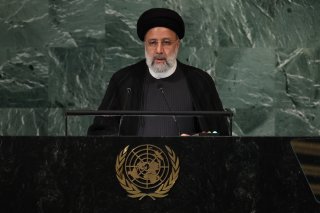Iranian Government Vows to Investigate Police Brutality
A video posted to social media on Tuesday showed policemen dressed in riot gear walking through an alleyway at night and attacking a man lying prostrate on the ground.
The Iranian government has reportedly launched an investigation after video footage circulated on social media depicting a group of Iranian policemen beating and then shooting a demonstrator involved in the country’s ongoing anti-clerical protest movement.
The two-minute video, posted to social media on Tuesday, showed the policemen dressed in riot gear walking through an alleyway at night and attacking a man lying prostrate on the ground. In the video, which was filmed from a nearby rooftop, the man attempts to protect his head and body from the attack using his hands. In response, one of the police officers begins to beat him with a baton. At the end of the clip, a policeman shoots the man with a firearm, tentatively identified as a pellet shotgun intended to be used at longer ranges to disperse crowds non-lethally. It was not immediately clear if the man had survived the incident.
Although Iranian police have been filmed beating other protesters during the month-long crackdown against the demonstrations, the video footage was widely shared inside Iran and prompted widespread outrage. Amnesty International described the footage as a “horrific reminder that the cruelty of Iran’s security forces knows no bounds,” urging the United Nations Human Rights Council to investigate the incident.
Although the Iranian government did not directly address the outcry surrounding the video, the Iranian police’s central command announced in a statement on Wednesday that it had launched an internal investigation intended to uncover the identity of the police officers involved in the beating, as well as that of the man who was beaten.
“The police in no way condone violence and unconventional behavior,” the central command’s statement read. “Offenders will certainly face legal measures according to the rules.”
The death of Mahsa Amini, the twenty-two-year-old Kurdish woman who was arrested by the country’s morality police for failing to properly wear a headscarf, in mid-September galvanized opposition to the Iranian government and sparked a series of anti-government demonstrations that soon spread across the country. Although the Iranian government claimed that Amini had suffered a heart attack while in police custody, eyewitnesses claimed that she had been severely beaten while in custody, leading to her death three days later.
The protests—framed both by demonstrators and by ruling officials as an attempt to overthrow Iran’s clerical government—have led to a violent crackdown by Iranian security forces. The Iranian government has not kept a record of deaths during the protests, but outside sources, including the Norway-based Iran Human Rights non-governmental organization, have estimated that more than 270 civilians have been killed in the violence, as well as dozens of members of the security forces. Thousands of Iranians have also been arrested for “rioting,” a crime that carries a harsh prison sentence.
Iranian leaders have refused to engage with the protesters, and several have publicly accused the United States, the United Kingdom, and Israel of planning and organizing the movement.
Trevor Filseth is a current and foreign affairs writer for the National Interest.
Image: Reuters

